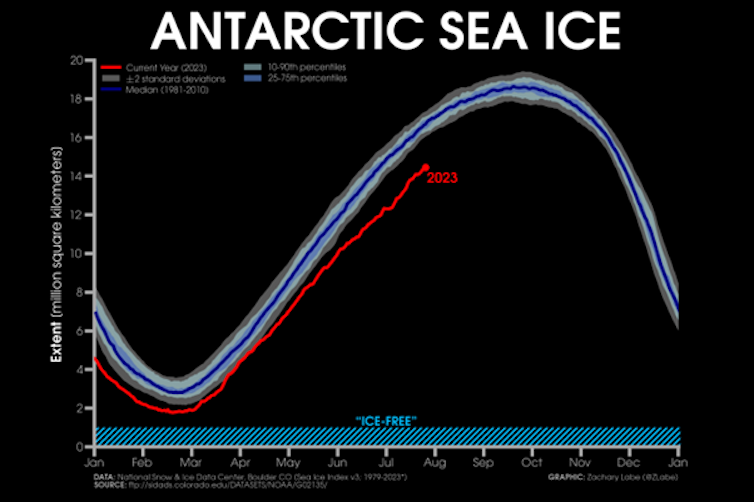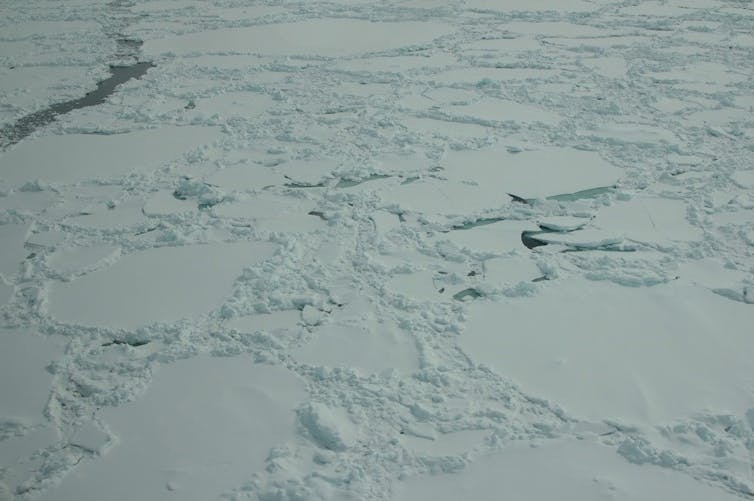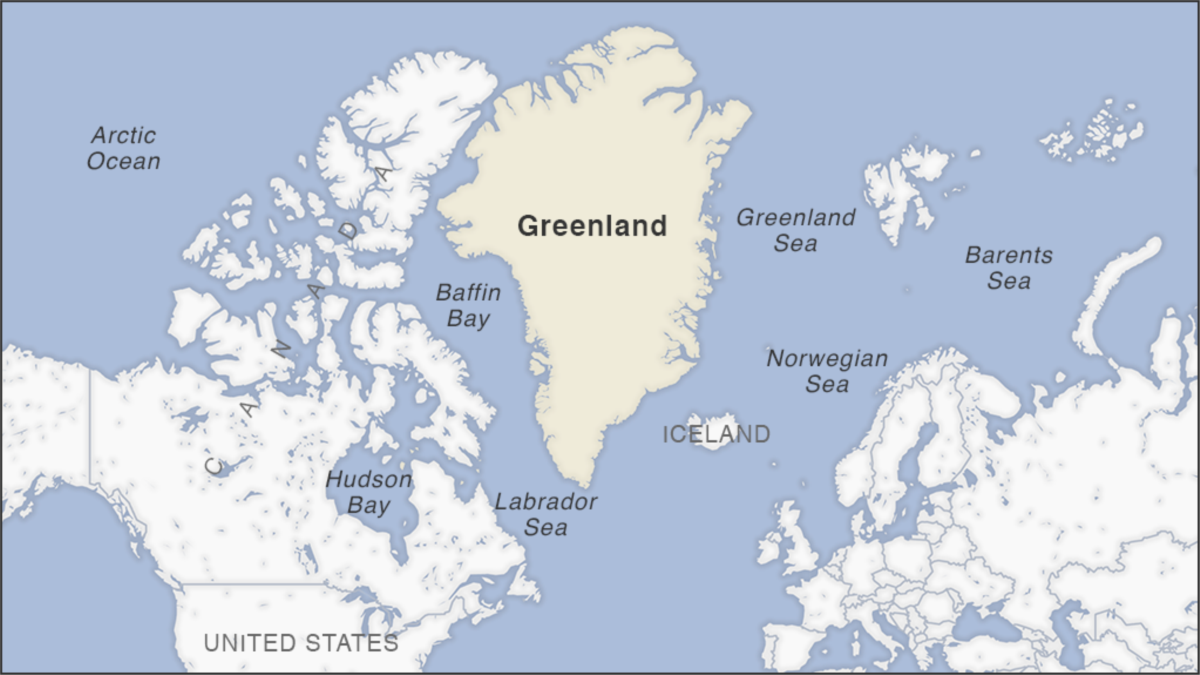Mon 14 August 2023:
Deadly heatwaves, raging wildfires and record global temperatures are upon us. But far from the flames, at the southernmost tip of the planet, something just as shocking is unfolding.
It’s Antarctic winter, a time when the area of floating sea ice around the continent should be rapidly expanding. This year though, the freeze-up has been happening in slow motion.
After reaching a record low minimum extent this summer there is now an area of open ocean bigger than Greenland. If the “missing” sea ice were a country, it’d be the tenth largest in the world.

Who cares about Antarctic sea ice?
In the face of more immediate climate concerns, why does Antarctic sea ice matter?
Floating sea ice is a pivotal climate puzzle piece. Without it, global temperatures would be warmer because its bright, white surface acts like a mirror, reflecting the sun’s energy back to space. This keeps the Antarctic – and by extension, the planet – cool.
Antarctic sea ice also plays a particularly important role in controlling ocean currents and may act as a buffer that protects floating ice shelves and glaciers from collapsing and adding to global sea levels.
In short, the loss of Antarctic sea ice matters for the whole planet.
Southern sea ice: a short history
Every year Antarctic sea ice undergoes a transformation: from its summer minimum in February, its area increases more than sixfold during the winter freeze-up which reaches its height in September. A clear way to monitor the health of Antarctic sea ice is to track these peaks and troughs.
Records began in 1979 and until 2015, the yearly average extent of frozen sea around Antarctica was increasing ever so slightly. Yet in the past seven years, Antarctic sea ice has changed dramatically.

Floating sea ice near the Antarctic peninsula in December 2017. Ella Gilbert
After a record high two years prior, the amount of sea ice fell dramatically at the end of 2016 to a record minimum in February 2017. This was followed by successive low years with the southern hemisphere summer record again being broken in February 2022 and most recently, a new lowest extent of 1.79 million square kilometres being recorded in 2023, a fall of nearly 10% from last year’s summer record.
Since February 2023, slow regrowth has meant sea ice has fallen further and further behind where it should be for the time of year.
And now, in July, what we’re seeing is truly remarkable.

A complex picture
Antarctic sea ice, and how it’s affected by climate change, has been so hard to understand because there are so many factors at play.
Wind patterns, storms, ocean currents and air and ocean temperatures all affect how much of the sea around Antarctica is covered by ice and they often push and pull in different directions. This means it can be hard to link the behaviour of Antarctic sea ice in any particular year, or over several years, to just one factor.
This complexity is behind the perplexing increase in Antarctic sea ice extent observed between 1979 and 2015, and what makes it so hard to understand current conditions.
Before 2015, contrasting trends in sea ice growth in different regions of the vast continent mostly counterbalanced each other. What’s remarkable about 2023 is that these regional differences are largely absent.
How rare is it?
This year’s record low summer minimum and record slow freeze-up are astonishing because they fall so far outside the range we have come to expect.
Antarctic sea ice varies a lot year-to-year, but even by Antarctic standards this is well outside the bounds of normality. Some experts have attempted to put a number on just how rare this would be without climate change and arrived at “a once in 7.5-million-year event”.
Not to be alarmist but…this is what’s called a six-sigma event, now unfolding in Antarctica.
Otherwise known as a once-in-7.5-million-year event.
Hang onto your hats.
HT @EliotJacobson pic.twitter.com/BnWIli8Rj3
— John Gibbons (@think_or_swim) July 24, 2023
However, while the current situation is certainly off the charts, those charts don’t go back very far, and so it’s hard to make these sorts of statements with any real certainty.
Given how complex a system it is, we can’t say conclusively whether the past 40 years (the period for which we have satellite observations) are an accurate reflection of the “natural” behaviour of Antarctic sea ice. In fact, there’s good reason to think they aren’t. Which makes it difficult to say exactly how unusual this year’s values are.
However, while we may not be able to put an exact number on it, we know that this is a rare event.
Is it climate change?
Compared with Arctic sea ice, the precipitous decline of which can be robustly linked to rising temperatures, Antarctic sea ice has proved more enigmatic.
In response to greenhouse gas emissions, models have long predicted a drop in Antarctic sea ice: a prediction that previously appeared at odds with the data.
As the ocean and atmosphere warm, we might expect sea ice sandwiched between the two to shrink. But as scientists have come to learn, Antarctic sea ice is more complicated than that.
Models seem unreliable on this topic, which means we still don’t know what Antarctic sea ice decline will look like. And while seven days may be a long time in politics, seven years is a short time when it comes to the climate. It is too early to say conclusively whether the recent dramatic fall in Antarctic sea ice extent is simply a blip in the record or, as now seems more likely, the first sign of a longer-lasting reduction induced by climate change.
What happens in Antarctica doesn’t stay in Antarctica
Regardless of the vagaries of Antarctic sea ice behaviour, the polar regions play a vital role in the climate system. And they are changing before our very eyes.
Antarctica isn’t just for the penguins: it matters for all of us.
Authors
![]()
Ella Gilbert
Ella Gilbert is a climate scientist at the British Antarctic Survey, working on the EU-funded PolarRES project (www.polarres.eu) that explores the future climate of the Arctic and Antarctic.
Her research interests include Antarctic weather and climate, high-resolution regional modelling, surface energy balance, atmosphere-ice interactions and cloud microphysics.
______________________________________________________________
![]()
Caroline Holmes
Polar Climate Scientist, British Antarctic Survey, Associate Lecturer, The Open University
My research at BAS seeks to understand how the current set of climate models used in climate change assessments simulates sea ice, and how this affects our future projections of climate change both within the polar regions and remotely. I am analysing output from the Coupled Model Intercomparison Project Phase 5 (CMIP5) used in the most recent IPCC assessment (2013) to evaluate how different models simulate the dynamic and thermodynamic processes important to the evolution of sea ice concentration. I work closely with BAS colleagues in both the Polar Oceans team and Atmosphere, Ice and Climate teams. This research is funded under the NERC large grant “Real Projections – Robust projections of real world climate change” led by Mat Collins at the University of Exeter.
I completed an undergraduate degree in Mathematics at the University of Cambridge, followed by an MSc in Atmosphere, Ocean and Climate at the University of Reading. With a particular interest in atmospheric dynamics, I pursued a PhD at the University of Reading Department of Meteorology. My thesis investigated the possible impacts of changes in sea ice cover on the midlatitude atmosphere, through idealised modelling experiments with imposed sea ice. I then undertook a short postdoc at the University of Edinburgh looking at impacts of climate change on Scotland in sectors such as building energy demand, before moving to the British Antarctic Survey to pursue research into the coupled climate system of the polar regions.
______________________________________________________________
FOLLOW INDEPENDENT PRESS:
TWITTER (CLICK HERE)
https://twitter.com/IpIndependent
FACEBOOK (CLICK HERE)
https://web.facebook.com/ipindependent
Think your friends would be interested? Share this story!





